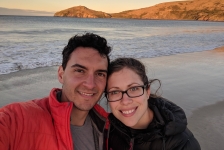My first involvement with the cohousing craze was in 1989. That was the year that some architects brought their research from a Scandinavian cohousing village to the burgeoning minds of the West Coast. My roommate was interested and got me involved. Dozens of people came to our large living room for regular meetings.
I was barely thirty years old and from a conservative background. Certainly I was interested but there were so many questions that would have to be answered. Living so closely, I was concerned about boundaries. Would there be nudity like what I found at several hip resorts of the NW? Could I handle settling down at this early stage of my adulthood? Was this a feel good concept that would not work out on a day to day basis? Were we supposed to all get along and not have any disagreements? That seemed impossible. And speaking of reality, how in the world would we go from this group talking endlessly about details to an actual residential setting?
Several years later, there has been progress in answering those questions. Friends got involved. Some friends were instrumental in their group getting new sites and set up. Others became residents later on in the process or post-completion. Some had very good stories and some were discouraged. I found in my conversations that both the positive and the difficult experiences revealed similar content.
Those who flourished in cohousing were those who were ready to find a new way of living and, in addition, had personalities that demonstrated that they were in charge of their destiny, which helped to weather the challenges met during the formation-to-construction process.
Those who were discouraged were often part of a group in both the initial stages of forming the group and the beginning of the cohousing experience. While they stuck out the early stage, the forming, norming storming stages burnt them out. Even with turmoil, they expressed that they got a lot from their experience and have since witnessed that the cohousing movement has systematized their processes in order to function more effectively. They still had friends who lived in the communities who were very satisfied. They assert that today, there is greater support and expertise to assist individuals and groups who are interested in cohousing.
These conversations were enlightening to me. The theory remained attractive to me and I thought it quite possible that I could enjoy life in a cohousing community.
More recently, it came time for me to find a new way to live. It had been thirty years since I attended those meetings. I ached for a greater sense of community. I wanted the small town feeling I grew up with. I wanted to connect to a group of people with whom I share a sense of meaning. I wanted more ease in my domestic life. I wanted a place where both my husband and I could relate to a new group of diverse friends.
I was delighted to search the internet and find the cohousing movement thriving. Since we traveled to Richmond, we decided to check the group out. We delighted in the joy we experienced, the intelligence among the members, how people live their values and the ease with which people moved through their lives. We were open to moving to other locations but found we were captivated by the qualities among the membership in Richmond. In addition, the setting of the condominiums fit our diverse needs and interests.
Today cohousing has evolved for greater likelihood of success and satisfaction of individuals and for the groups. I feel more trust in myself and in the process. We are under contract and will move in only a few months.
Across my adult lifespan I traveled across the country to find this home, this setting, these people. With our collective processes we create a new sense of an awakened home. Like the movement, I have studied groups, examined my needs, matured and clarified my dreams. Richmond Cohousing contentedly maps my future.







 We chose cohousing because we both want to live in close community with our neighbors, and we want our kids to have other people around to learn from and play with. We want to support our older neighbors as they age in place, and are comforted knowing that our neighbors will help us in times of need. We look forward to eating dinner all together, to watching sunsets from the rooftop deck with a glass of wine, and perhaps throwing in a game of ping pong or Pictionary before heading to bed. We hope – and believe – that more people will choose to live this way as it becomes clear that human connection is the key to happiness.
We chose cohousing because we both want to live in close community with our neighbors, and we want our kids to have other people around to learn from and play with. We want to support our older neighbors as they age in place, and are comforted knowing that our neighbors will help us in times of need. We look forward to eating dinner all together, to watching sunsets from the rooftop deck with a glass of wine, and perhaps throwing in a game of ping pong or Pictionary before heading to bed. We hope – and believe – that more people will choose to live this way as it becomes clear that human connection is the key to happiness.